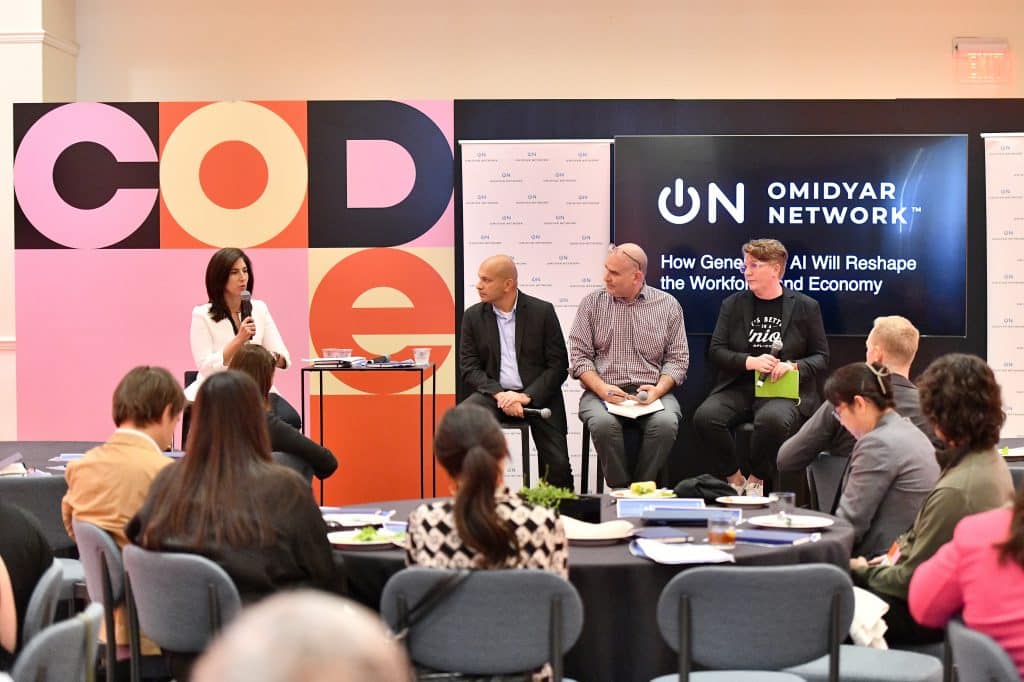Experts discussed the importance of centering workers in the transition to an AI-economy
By Lauren Alexander, Omidyar Network
This week, Omidyar Network convened a panel of experts at Code 2023 to discuss the impact of generative AI on the future of work. Building on Omidyar Network’s recently released position paper on generative AI, panelists joined Rana Foroohar of the Financial Times to discuss their shared vision for a responsible, inclusive AI economy — and the government, labor, and industry collaboration needed to make that vision a reality.
Joining Rana for the conversation were Roy Bahat, head of Bloomberg Beta; Amanda Ballantyne, director AFL-CIO Technology Institute; and Tolga Kurtoglu, managing partner & CEO at LeapAI, Inc. and Omidyar Network board member. The robust conversation focused on how leaders can make intentional choices about technology that considers the impact on workers and the workplace in order to build community resilience and improve socioeconomic mobility.
Workers as a “countervailing” force
While generative AI is evolving at a pace we haven’t seen before, it’s not the first time that the workforce has been transformed by new technology. In her opening comments, Amanda likened the emergence of generative AI to the adaptation of electricity, another embedded and ultimately ubiquitous technology. At the turn of the 20th century, workers were at the forefront of electrification — not just because they were needed to install power lines — because people on the frontlines fought to make electrification safer. They banded together to demand safety regulations, and today, she argued, workers must do the same with generative AI.
All panelists agreed the labor movement and workers will play a critical role in responsible AI adaptation. As Amanda put it, unions are a “countervailing force” that help balance workers’ well-being against the rush of any new technology.
“Cranes not looms”
Roy shared his “cranes not looms” framework, arguing that generative AI can augment human capabilities rather than replace them. There is a difference “between a loom, which is a piece of technology that replaces a human being, and a crane, which is a piece of technology that does something that even given infinite time human beings can not…even given infinite time, human beings cannot lift a steel rivet 30 feet into the air.” As generative AI continues to evolve, we must prioritize technology that complements and enhances workers’ abilities, while at the same time, being clear-eyed about where we need to account for major replacement effects.
The need for urgency and transparency, even when we don’t have all the answers
As Tolga explained, very few people (if any!) truly understand the inner workings of generative AI. But there are several critical elements — including data governance and privacy — that regulators have dealt with in the past, and can build foundational regulation upon. The regulatory process must start now, he argued, instead of waiting until we think we know everything. Similarly, Amanda also stressed the need for quick action to rethink safety nets and worker well-being, stressing that we should start “regulating what we know is a problem right now.”
Roy stressed the need for transparency in generative AI regulation. By making transparency a guiding principle in our collective approach to AI, we’re giving workers, civil society allies, and regulators power in this process.
The vast promise of generative AI
While the panelists wrestled with the challenges posed by generative AI, they were optimistic about its immense opportunity. Tolga used healthcare as an example, noting the nearly “limitless possibilities” of generative AI in the clinical setting — from decision-making to wellness tools to back-office processing of claims — to improve provision efficiency and the patient experience.
Roy argued that the challenges of AI could not — and should not — be divorced from its promise. “If we want to accelerate technology, which I do,then the more we can address these things, the faster we can go.”
Ultimately, all panelists underscored the need for collaborative action that balances the vast opportunities of generative AI with its inherent risks.
The start of a critical conversation
The conversation around generative AI is just beginning. Omidyar Network appreciates the insights and expertise of our panelists and our skilled moderator. We look forward to further discussions as we all work to create a generative AI future that fosters inclusive participation and connection, augments human capability, and enables smart and nimble regulation that delivers meaningful accountability while spurring world-class innovation.
About Code 2023
Twenty years in the run, Code has established itself as the country’s premier conference on tech and media for the last 20 years, bringing together the most influential voices shaping the future of technology and business. The invitation-only conference convenes the titans of tech — the founders, CEOs, investors, and visionaries driving innovation in tech, media, commerce, and finance — for networking and in-depth conversations. This year’s event took place September 27–28 in Laguna Niguel, CA.

